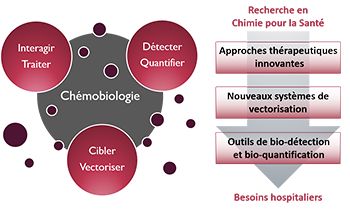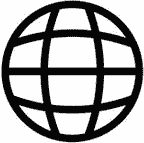- ⌂
-
Le DPM
Les Equipements
L'Environnement
Zoom sur... Le Bâtiment André Rassat
Nommé d'après une figure tutélaire de la chimie grenobloise, ce bâtiment est recouvert d’une double peau en feuille métallique qui apporte une protection thermique sur 3 côtés et crée une unité architecturale favorisant l'intégration parmi les arbres du site.
-
Thématiques
Le Thème
« Approches thérapeutiques innovantes »De nouvelles solutions thérapeutiques, de la cible biomacromolécu-laire émergente aux approches originales pour traiter les maladies
Le Thème
« Nouveaux systèmes de vectorisation »Combiner les propriétés d’inclusion de principes actifs, de franchisse-ment de barrières, d’adressage et de relar-gage en milieu vivant
Le Thème
« Outils de bio-détection et bio-quantification »Des dispositifs analytiques originaux pour la détection de cibles, de l’ion au micro-organisme en milieu complexe
Zoom sur... La Chémobiologie

-
Équipes
L'Équipe « COMET »
« COMET » développe la conception rationnelle, la synthèse et/ou l'extraction de composés à forte diversité/complexité comme nouveaux agents thérapeutiques et outils moléculaires pour la pénétration cellulaire ou la détection de biomolécules, actifs in vivo.L'Équipe « NOVA »
« NOVA » utilise des acides nucléiques fonctionnels comme éléments de reconnaissance pour des applications thérapeutiques ou diagnostiques, comme la sélection d'oligonucléotides, ou le développement de dispositifs d'analyses et de nanovecteurs.Les Services
-
Productions
Les Publications
La Vulgarisation
Les JSM
Zoom sur... La 12ème JSM (15 juin 2023)
Le DPM organise des journées scientifiques consacrées au médicament. L'objectif est de rassembler les spécialistes académiques et industriels autour d'une thématique. 2023 : Apports de la Chimie Click et de la Lumière en Chemobiologie
-
Partenariats
Les Formations
Les Consortiums
Les Financements
Zoom sur... L'environnement Grenoblois
Le DPM est un acteur central sur le bassin grenoblois en chimie, biologie et santé, lié au CHU Grenoble Alpes et à de nombreuses autres organisations : Pole de Recherche CBS, ICMG, Labex ARCANE, EUR CBH, Institut Carnot Polynat, Réseau GREEN.
Article
- Projet
- Jean-Luc DECOUT, Marine PEUCHMAUR,
- Titre
- Antibiotic drugs aminoglycosides cleave DNA at abasic sites: Shedding new light on their toxicity?
-
[Full paper
 ]
] - Auteurs
- M. Perigolo, J.-F. Constant, M. Peuchmaur, I. Pitta, J.-L. Decout.
- Edition
- Chem. Res. Tox. 2013, 26, 1710–1719.
- Année
- 2013
- Résumé
- Abasic sites are probably the most common lesions in DNA resulting from the hydrolytic cleavage of glycosidic bonds that can occur spontaneously and through DNA alkylation by anticancer agents, by radiotherapy, and during the repair processes of damaged nucleic bases. If not repaired, the abasic site can be mutagenic or lethal. Thus, compounds able to specifically bind and react at abasic sites have attracted much attention for therapeutic and diagnostic purposes. Here, we report on the efficient cleavage activity of characteristic antibiotic drugs of the major aminoglycosides (AG) family at abasic sites introduced either by depurination in a plasmidic DNA or site specifically in a synthetic oligonucleotide. Among the antibiotic AG drugs selected for this study, neomycin B is the most efficient (a 0.1 μM concentration induces 50% cleavage of an abasic site containing DNA). This cleavage activity could be related to aminoglycoside toxicity but also find medicinal applications through potentiation of cancer radiotherapy and chemotherapy with alkylating drugs. In the search for antibiotic and antiviral agents, we have previously described the synthesis of derivatives of the small aminoglycoside neamine, which corresponds to rings I and II of neomycin B constituted of four rings. The cleavage activity at abasic sites of four of these neamine derivatives is also reported in the present study. One of them appeared to be much more active than the parent compound neamine with cleavage efficiency close to that of neomycin.




 Annuaire
Annuaire Contact
Contact Plan d'accès
Plan d'accès ENG
ENG Login
Login



